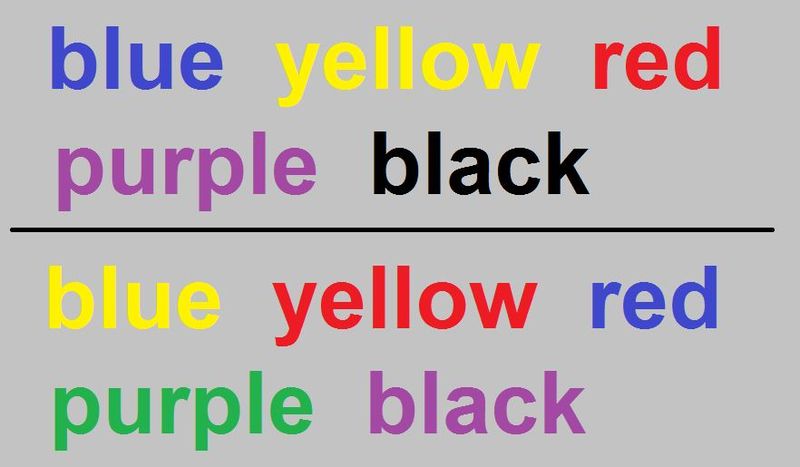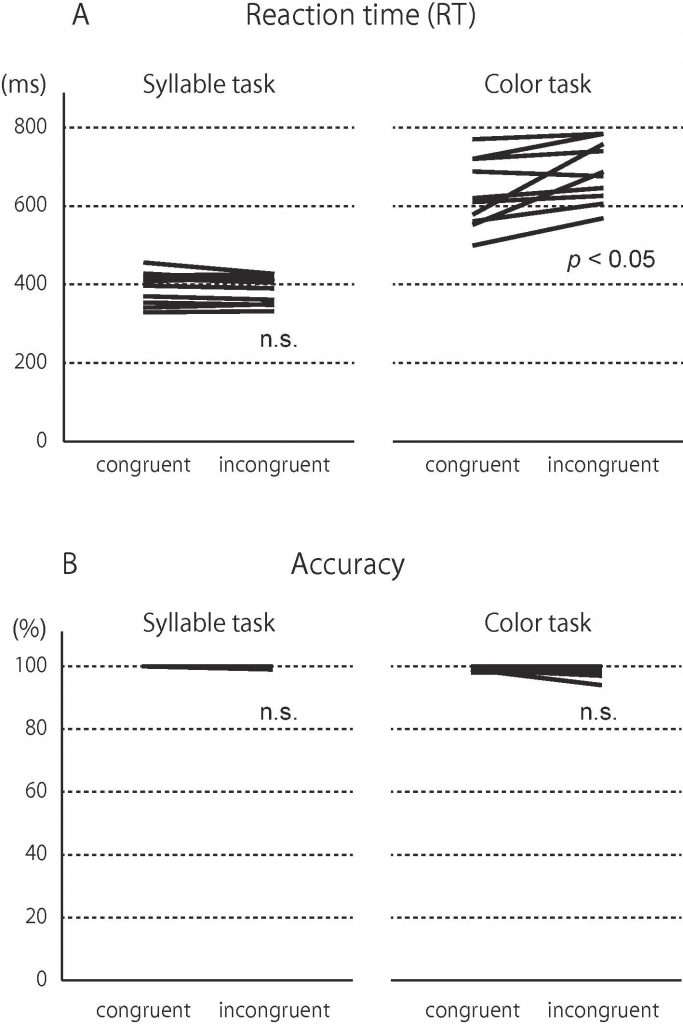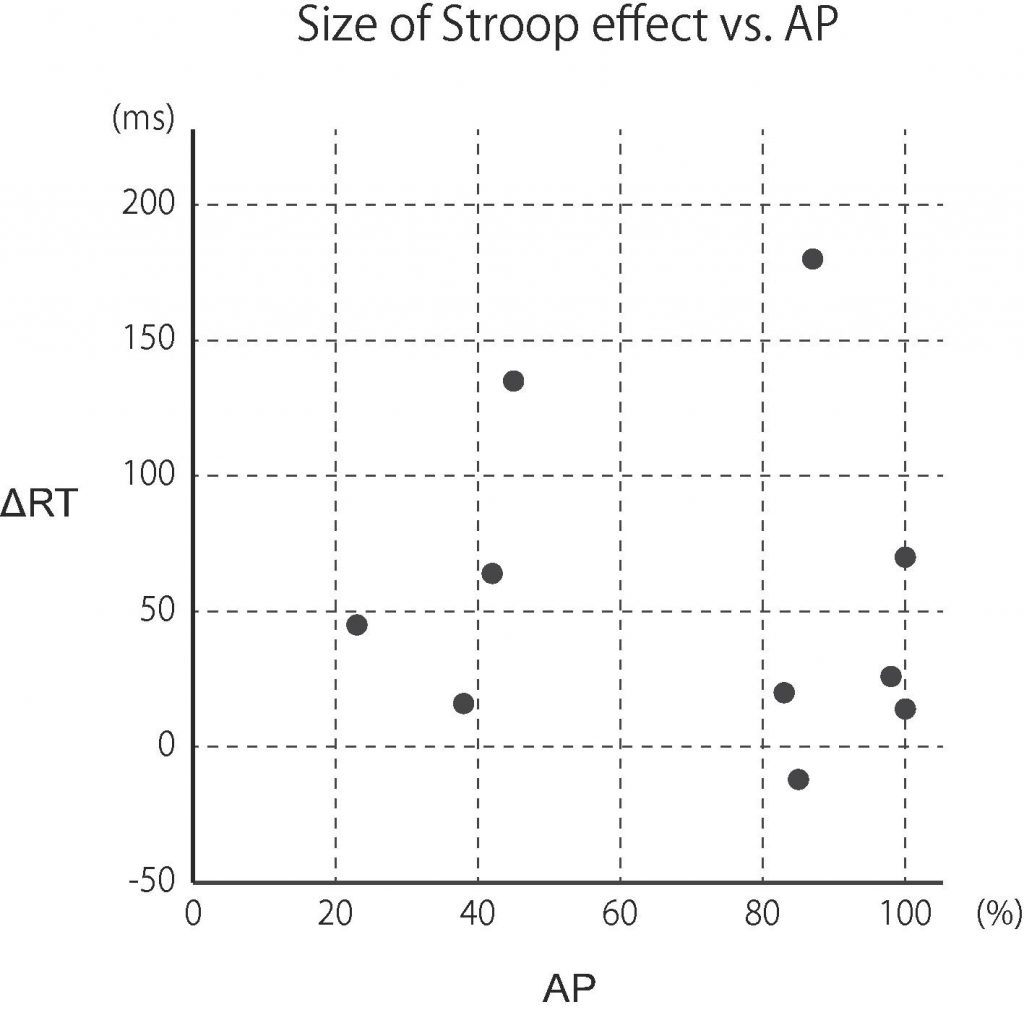Title of paper under discussion
Automaticity of pitch class-color synesthesia as revealed by a Stroop-like effect
Authors
Kosuke Itoh, Honami Sakata, Hironaka Igarashi, Tsutomu Nakada
Journal
Consciousness and Cognition, Volume 71, May 2019, Pages 86-91
Link to original paper (open access)
Overview
Synaesthesia is a merging of senses that aren’t normally connected, whereby the stimulation of one sensory pathway (e.g. sight) lead to involuntary experiences in a second sensory pathway (e.g. smell). To get an idea of life as a synaesthete, read this short description by the President of the UK Synaesthesia Association (he’s a taste/sound synaesthete).
This week’s paper under discussion looked at a particular set of synaesthetes, pitch/colour synaesthetes – people who involuntarily experience colour when hearing musical pitch. So, for example, to one pitch/colour synaesthete the note C might always sound red, D purple, E green etc. It’s important to note that each synaesthete has his/her own particular set of pitch/colour relationships, so another synaesthete might always experience C as green, D as purple etc.
[By the way, the researchers looked specifically at pitch class (pitches in the scale) rather than pitch height (which octave of that scale); pitch/colour synaesthetes commonly describe pitches as having brighter colours, but of the same hue, at higher octaves]
One way of investigating the strength of these pitch/colour relationships is a Stroop test. In a Stroop test participants are presented with an “incongruent stimulus” – a stimulus with features that evoke two contrasting perceptions, for example the word blue in printed in yellow ink, or the word purple printed in green ink. They are also presented (as a control) with “congruent stimuli”, with features that evoke the same perceptions e.g. the word blue printed in blue ink. The Stroop test asks the participant to name one of the features – e.g. the colour of the word, or the pronunciation of the word – and looks for the delay in reaction time when asked to do so. The idea is that the longer the delay in naming one feature of an incongruent stimulus (e.g. its colour or its pronunciation) the stronger must be the sensation being evoked by the competing feature (its pronunciation or its colour respectively).

Each participant in this research underwent pitch/colour Stroop tests to test the strength of their pitch/colour relationships. Itoh and his colleagues found that the pitch/colour relationships were significant (as measured by the delay in naming incongruent stimuli) but that the relationship was not significantly stronger in people with absolute (‘perfect’) pitch.
Method
Ten pitch/colour synaesthetes were first assessed for their ability to name pitches without reference to a home pitch or key; this gave each of them an “absolute pitch” score.
They were then presented with pitch/colour Stroop tests. [In previous research each participant had been assessed for their particular pitch class/colour relationships, so each had their own chart describing these relationships]. The congruent stimuli in the Stroop tests were the names (called “syllables” in this paper) of pitches in fixed solfège (C = do, D = re, E = mi etc) coloured according to that synaesthete’s own pitch/colour relationship chart. The incongruent stimuli were pitch names coloured differently from that participant’s own chart.
Two Stroop tests were given: 1) Syllable task, in which the participant read out loud (“as soon as possible”) the solfège syllable (pitch class) in front of them, ignoring its colour and 2) the Colour task, in which the participants read out loud (“as soon as possible”) the font colour of the solfège syllable, ignoring its pitch class information. Each participant had 70 examples presented in each task, half of the examples congruent, the other half incongruent.
The researchers recorded the accuracy and speed (reaction time, or RT) of their answers.
Results
Reaction time and accuracy results are presented in this table:

In these graphs above, each solid line represents one participant. “n.s.” means there was ‘no significant difference’ (in RT or accuracy) between congruent and incongruent examples. A significant difference found was between Reaction Times to congruent and incongruent examples in the Colour Task; the upward slope of the lines show that the participants were taking longer to name the font colour when it differed from the colour they associated synaesthetically with that pitch.
The results of the investigation into whether a participant’s level of Absolute Pitch affected the size of the Stroop effect (the difference between their congruent and incongruent Reaction Times) are presented in this graph:

The graph above demonstrates, with this sample at least, that there was no clear correlation between Absolute Pitch and the size of the Stroop effect.
Discussion – the Two Stage process
The outstanding finding from this research is the significant Colour Task Stroop effect; in the words of Itoh “the speed of reporting the font color of a pitch name syllable was delayed when the font color was incongruent with the synaesthetic sensation”. This means that colour sensations are occurring automatically to these participants, even though they are unnecessary. This automatic occurrence points to a true synaesthesia.
The fact that the Syllable Task showed no Stroop effect (reading out pitch class names was not affected by their colour incongruency) suggests that the synaesthetic association between pitch class and colour is “asymmetric or unidirectional” – the “pitch class ➡️ colour” association is more automatic than the “colour ➡️ pitch class” association.
Of course in listening to music the “pitch class ➡️ colour” association happens in two stages: Stage One – hearing the pitch ➡️ pitch name and Stage Two – pitch name ➡️colour. This research deliberately isolated Stage Two (by presenting pitches as names, not sounds), and demonstrated Stage Two was highly automatic.
Furthermore, the finding that possession of Absolute Pitch (AP) does not increase the Stroop effect corroborated a previous discovery of this research team: namely that AP facilitates Stage One, not Stage Two of this two stage process. No surprise then that an investigation into Stage Two reveals no effect of AP.
Coda
Prometheus – Poem of Fire by Alexander Scriabin (composer and synaesthete)